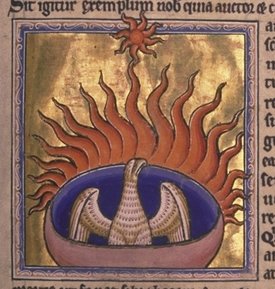Phoenix
|
|
- This article concerns mythical fire birds in Egyptian and derivative myths. For the Chinese phoenix, see fenghuang. For other uses of the name Phoenix, see Phoenix (disambiguation).

In ancient Egyptian mythology and in myths derived from it, the phoenix is a mythical sacred firebird.
Said to live for 500 or for 1461 years, the phoenix is a male bird with beautiful gold and red plumage. At the end of its life-cycle the phoenix builds itself a nest of cinnamon twigs that it then ignites; both nest and bird burn fiercely and are reduced to ashes, from which a new, young phoenix arises. The new phoenix embalms the ashes of the old phoenix in an egg made of myrrh and deposits it in Heliopolis ("the city of the sun" in Greek), located in Egypt.
Although descriptions (and life-span) vary, the phoenix became popular in early Christian art and literature as a symbol of the resurrection, of immortality, and of life-after-death. The early Christians were convinced the phoenix was a real living creature.
Originally, the phoenix was identified by the Egyptians as a stork or heron-like bird called a benu, known from the Book of the Dead and other Egyptian texts as one of the sacred symbols of worship at Heliopolis, closely associated with the rising sun and the Egyptian sun-god Ra.
As Britannica 1911 continues:
- ... whence it is represented as "self-generating" and called "the soul of Ra (the sun)," "the heart of the renewed Sun". All the mystic symbolism of the morning sun, especially in connexion with the doctrine of the future life, could thus be transferred to the benu, and the language of the hymns in which the Egyptians praised the luminary of the dawn as he drew near from Arabia, delighting the gods with his fragrance and rising from the sinking flames of the morning glow, was enough to suggest most of the traits materialized in the classical pictures of the phoenix.
The Greeks adapted the word benu (and also took over its further Egyptian meaning of date palm tree), and identified it with their own word phoinix, meaning the colour purple-red or crimson (cf Phoenicia). They and the Romans subsequently pictured the bird more like a peacock or an eagle. According to the Greeks the phoenix lived in Arabia next to a well. At dawn, it bathed in the water of the well, and the Greek sun-god Apollo stopped his chariot (the sun) in order to listen.
This myth is famously referred to in Shakespeare's play The Tempest,
- that in Arabia
- There is one tree, the phoenix' throne; one phoenix
- At this hour reigning there.
- -(III.III.28)
One inspiration that has been suggested for the Egyptian phoenix is a specific bird species of East Africa. This bird nests on salt flats that are too hot for its eggs or chicks to survive; it builds a mound several inches tall and large enough to support its egg, which it lays in that marginally cooler location. The hot air rising around these mounds resembles the turbulence of a flame.
External links
- Entry for the Phoenix in The Aberdeen Bestiary (http://www.abdn.ac.uk/bestiary/translat/55r.hti)bg:Феникс
da:Fugl Føniks de:Phönix (Mythologie) fi:Feeniks fr:Phénix he:עוף החול it:Fenice nl:Feniks ja:フェニックス pl:Feniks (mitologia) ru:Феникс th:ฟีนิกซ์ zh:凤凰
